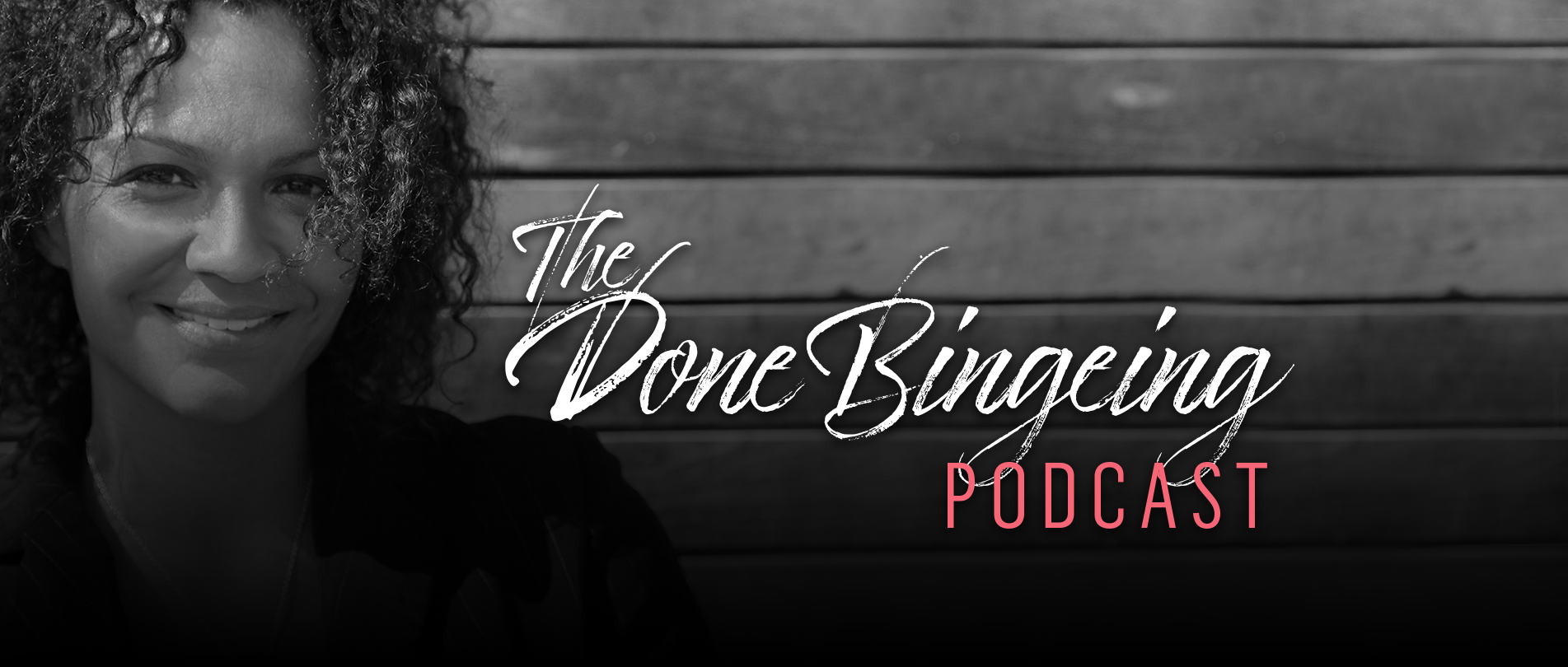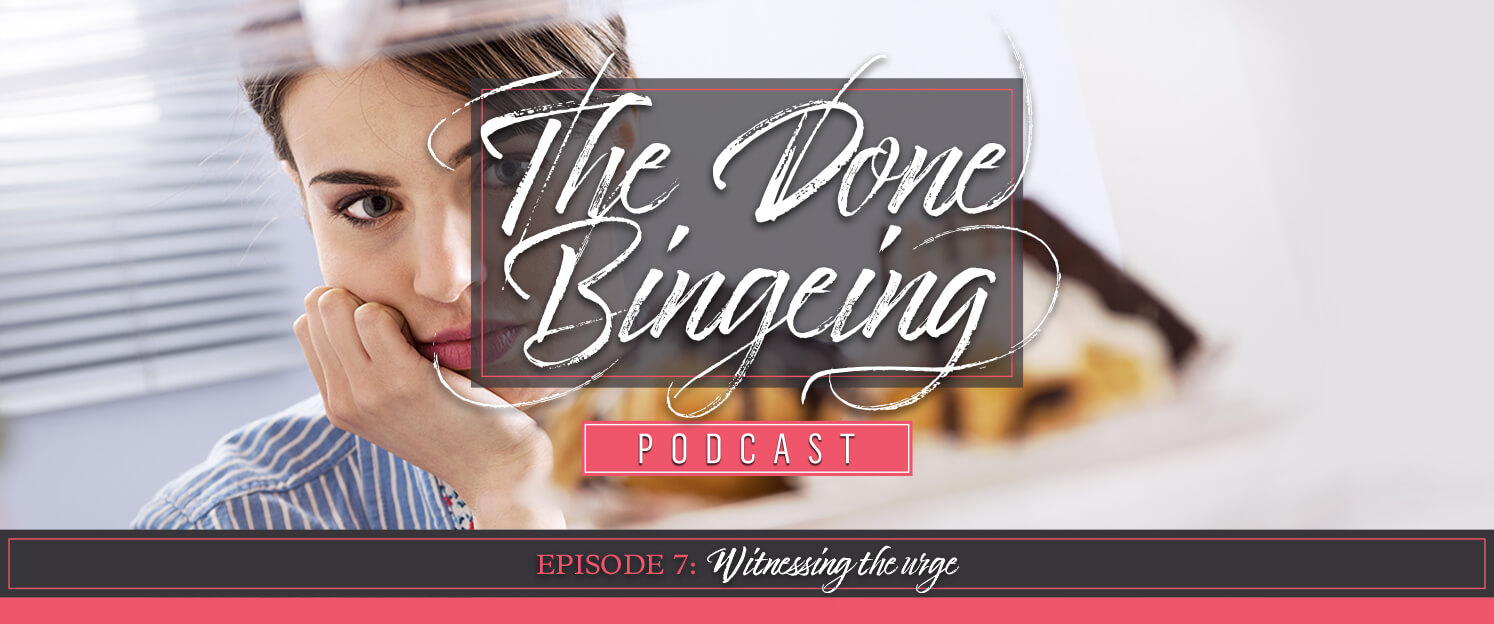
EP #7: Witnessing the urge

The last thing you want to do is hang around with the urge to binge, right? There’s no doubt that your urge is super-compelling. But there’s also no doubt that your prefrontal cortex is super-powerful. Armed with the brain science we covered in the last episode, you can learn how to defuse the urge to binge by witnessing it. And nothing defuses your urges like compassionate curiosity—you’ve got it, a form of self-regard!
Episode 7 teaches you how to track what’s happening for you during an urge and how to disengage from any drama with the technique called the “Behind-the-Scenes Movie Trick.” You’ll learn that you don’t have to binge to make the urge go away. You’ll also learn that you have two powerful allies with you on your journey to end binge eating. Listen in to find out more.
This episode continues the conversation we began in Episode 3 about how self-regard will get you a whole lot closer to ending your binges. Episode 4 focused on weight, Episode 5 looked at dieting. Episode 6 began to tackle the urges to binge. The following weeks will continue to discuss the urge to binge and will also cover the bingeing itself, the aftermath of bingeing, and weight loss after the bingeing has stopped.
Get full show notes and more information here: https://www.holdingthespace.co/7
Episode: Play in new window
Subscribe: iTunes | Google Play | Stitcher | RSS
- Why you need a witness and how to find one. (Pssst. You don’t have to look far.)
- How to describe and articulate your urge to binge before it takes you by storm.
- Why you’re totally fine, even when the urge to binge feels really scary.
- Why the urge to binge is no match for your higher brain.
- How to teach your brain to begin to dismantle the urge-binge pattern.
- The two powerful allies with you on your journey to end binge eating.
- Kathryn Hansen
- Cookie Rosenblum
- “Clash Defiant,” “Metalmania,” and “Too Cool” by Kevin MacLeod (incompetech.com). Licensed under Creative Commons: By Attribution 3.0, http://creativecommons.org/licenses/by/3.0/
How could imagining a zombie stumbling through a misty graveyard save you from a binge? Keep listening!
Welcome to the Done Bingeing podcast, where you’ll hear about powerful life coaching strategies that empower you to end binge eating.
Binge eating is no joke. So, explore all your options. If you’re functioning well in your life and you want to explore a non-clinical approach to stop bingeing, coaching might be perfect for you. Life coaching isn’t therapy, but it may help you on your journey whether you also choose to do therapy or not. Trust yourself, take good care of yourself, get the support you need, and see what works for you. If you want to hear how life coaching can help free you from binge eating, you’re in the right place! You have more power than you know. Why not take it back? And now, your host, Life and Weight-Loss Coach Martha Ayim.
Welcome to Episode 7 of the Done Bingeing Podcast. Thank you for being here with me.
In Episode 3, I began to investigate the concept of self-regard and, since then, we’ve been considering how self-regard plays a central role in six main areas that binge eaters tend to face:
1. their unhappiness with their weight
2. their attempts to diet to lose that weight and to control their eating
3. their urges to binge
4. the bingeing itself
5. the aftermath of bingeing
6. dealing with their weight after the binges have stopped
Episode 4, I focused on #1: the weight. Episode 5 tackled #2 food restriction. Episode 6 explored the reason we get urges in the first place.
And this week, in Episode 7, we’re going to talk about how to defuse the urge to binge by witnessing it.
Armed with the brain science we covered in the last episode, you can respond differently to an urge to binge when it comes. I want you to hear me say that again. When you understand the brain science, you can respond differently to an urge to binge.
This was huge for me. So huge in fact that you may remember me sharing in the first episode that one of the life-altering events that ended my binges was attending a workshop on addiction recovery, where I learned about the neuroscience behind binge eating. I learned that my brain had the capacity to respond differently to an urge. I didn’t need to automatically binge to make the urge go away. From that day forward, I began to see the urge as something other than an overpowering monster. And I learned how to take the power out of my urges, to defuse my urges.
Now, one thing I can say for sure is that nothing defuses your urges like compassionate curiosity—you’ve got it, a form of self-regard! You probably know by now that I’m a huge fan of self-regard.
It often seems like an urge requires a frantic reaction of bingeing. In fact, an amazing author named Kathryn Hansen argues that we binge for one reason—to make the urge to binge go away. End of story. The urge is that compelling. Kathryn argues that we don’t need to have some entrenched psychological reason for bingeing that we have to resolve before we can stop bingeing.
I joined Kathryn’s support group after I’d stopped bingeing but still lived in fear that the bingeing would return because I’d done it for so long. While I was in the group, I saw how powerful Kathryn’s theory was. In her group, she teamed up with Master Life Coach Cookie Rosenblum, another amazing coach. Their group felt like a kind of insurance for me while I needed it.
And, I agree, there’s not necessarily a psychological component to binge eating for every person who binges. Now some clients greatly benefit from life coaching strategies that go beyond learning how to defuse an urge and also focus on confronting difficult emotions that trigger binges in some people. Every binge eater’s needs and history are different. And not only that, a single binge eater’s experience can vary with time. My binges spanned more than three decades. And so my experience of my urges and triggers changed noticeably from my early teens to my late forties.
So, let’s get back to defusing an urge. How do you disarm it and take the power out of it?
You sit back and you watch.
Now, I can hear you already. The last thing you want to do is hang with the urge. So, to help you get just enough distance from the urge to encourage you to stick around, you’re going to watch it as a neutral observer, as a witness.
What’s a witness, you ask? Well, you know how you can have perspective and offer support to a friend, or someone who’s not you? That’s what I’m talking about. What if you could step back and see yourself in that same relaxed, non-judgy way? It’s called being a witness or “holding the space.” You can be a witness for your experience the way you can be a witness for your friend’s. Increasing your awareness in just this way will be central to aligning your actions with the outcome you so badly want to create: a life without bingeing.
In fact, holding the space for yourself is so profoundly important to our work that I made it the name of my business so I’d never forget it. Holding the space is such a central concept that it’s also the reason why I’ve started this podcast by focusing so much on self-regard. Self-regard sets you up to be a neutral, compassionate witness—in other words, to hold the space—for whatever unfolds for you.
I think you’re in a good place to hold the space for yourself if you’ve been listening to this podcast from the beginning. In prior episodes, we’ve talked about dropping the hate and naming the shame that often lingers around binge eaters. By now, I hope you’ve let go of the hatred and shame. If not, go back and listen, so you’ll be ready for this exercise.
Here’s what I want you to try:
Imagine you had to write a screenplay for James Cameron to capture the character of your urge. What would your urge look like? Who or what would play it?
The next time an urge to binge stirs, imagine yourself sitting across from an empty armchair and . . . wait. Remember, there’s nothing to fear. You’re safe in your armchair, just watching a scene play out.
Okay, so why are we doing this “screenplay” exercise? We’re doing it to try to better describe and articulate the urge. To try to see it. Many binge eaters binge before they know what hit them. They often can’t remember much in the moments leading up to the binge. I recall times when I’d look down at the crumbs on my plate, bewildered that I couldn’t remember much of what had just happened.
Well, we want to get to know these moments, to observe them, to watch them, to witness them. And now that we’re no longer filled with shame, there’s nothing to be afraid of.
What does this “screenplay” exercise look like? Well, let’s see. You’re sitting relaxed, waiting, and watching in your armchair, remember? Before you go any further, be sure to wake up your witness. You’re not gonna wanna miss this!
Maybe your urge enters, stage right, like this:
He sashays into the room, not even bothering to knock, almost pretending you’re not there. His white jeans are tight enough to reveal definition in his thighs. You don’t want to stare so you lift your eyes to his shirt—a pastel linen that opens to tufts of curly hair. You start counting backward from ten to calm down. What’s that scent? Is that Givenchy or pheromones? Nine – eight – seven. He sits and you wonder if a seam might split. Six – five – four. His long, manicured fingers reach up to his silvery streaked hair, which he strokes. Three – two – one. He slowly closes thick lashes into a wink. Zero.
Or maybe your urge looks more like this . . .
You hear him long before you see him—a motorcycle engine tearing through the air. Louder now. Closer now. Then a long, shrill screech. Then nothing. You stand up. There’s a crash. Dear God. Did he just let his bike fall? You sit down. He kicks the door open and it smashes into the wall. His black boots stomp down the hall. He rips his shades off and throws them onto the floor. Then he turns to you.
Or perhaps your urge doesn’t even feel human . . .
Maybe she’s a lioness with golden fur and golden eyes. She rips the door right off its hinges. (And you thought the Biker Dude Urge was bad.) The lioness gives no warning and makes no sense. She doesn’t run. She doesn’t have to. Sharp, white claws click elegantly, methodically, down the hall. She shreds that armchair across from you in one swipe. She circles you. Then . . . she approaches with a surety that stops your breath.
Who knew that your urge could have such personality!
Sometimes it might feel like an arrogant seducer. Sometimes, like an intruder. Sometimes, a stalking predator. But whether it feels like a tease, an attack, a hunt, or something entirely different, I want you to remember that the urge isn’t you. It’s just old wiring sending out an old—often theatrical—signal.
Now, whether you join the drama or watch it play out is entirely your decision. Why? Because while your reptilian brain is sending out a dramatic urge to binge, it’s the most evolved part of your brain that chooses what to do about that urge. And that is the best. news. ever.
So, now that you have a sense of all the drama unfolding in your urges to binge, how do you disengage from the drama? You might be wondering, “How am I supposed to be neutral about these urges that I dread and totally loathe and that completely take over my body?”
Here’s how. I’m going to show you a technique I call the “Behind-the-Scenes Movie Trick.”
Let’s say you’re feeling the urge, and you remember there’s a family-size bag of Ruffles in the pantry.
Before you’ve moved a muscle, there’s already a movie playing in your head of you opening the bag and tasting the salty crunch, and your head is screaming, “I’ve got to eat every last one of those chips, right now!”
So how do you not let the images, sensations, and thoughts dictate whether you eat the chips?
Well, think about this for a moment:
You’ve probably been to a horror movie and it’s pretty scary. Maybe there’s a hoard of zombies stumbling through a misty graveyard and descending on an unsuspecting town. But you’re able to pull yourself back from having a meltdown because you understand what goes on behind the scenes.
There’s a director following the script.
There’s actors playing the roles.
And there are special effects like dry ice machines and a couple of buckets of fake blood.
When you understand that all these things are happening to make this imaginary thing come together, it allows you to watch the movie and sort of feel scared but enjoy the ride knowing that it’s just a ride. You know that these are fake zombies, not actual dead people coming to eat you.
In other words, the movie’s neutral. The neutrality takes the power out of the freak-out, so you don’t run out of the theater screaming and peeing your pants.
So how do you apply this same strategy to feel neutral about your urges?
Well, you know what goes into making a movie. So, it’d be helpful to remember what goes into making your urges, right?
Well, here’s another peek behind-the-scenes in your brain.
We’ve already talked about the two main jobs of your older, less-evolved lower brain. First, to keep you alive by sending you impulses for anything it thinks you need to live—which includes food. Second, to help you run more efficiently, and it does that by automating patterns that it notices happen repeatedly.
It’s kind of like autocorrect—if autocorrect worked better. You know how autocorrect sometimes starts recognizing words that you type a lot and finally starts to auto-fill them? That’s what your lower brain does with your habits. Like, “Oh. Okay. That’s a habit I recognize, it’s worked for us before. It’s kept us alive. I’m gonna make it automatic.”
So, when you have an urge to binge and you react to this urge by bingeing again and again, your lower brain recognizes that as your pattern. So, your lower brain sets up the urge-binge cycle as an automatic function.
Your lower brain is making a movie that’s faking you into thinking the urge is a real monster—a monster inside of you that can force you to the Ruffles. But gentle curiosity—a form of self-regard (yay!—let’s hear it for self-regard)—lets you pull back the curtains long enough to see what’s really going on behind the scenes.
Now that you understand what’s happening, you can say to yourself when your feel the urge, “Oh, this is just a movie. Even though it feels pretty real, it’s not. I don’t have to run to the chips. I’ll survive just fine without them.”
What’s going on in your brain isn’t bad or good—it’s just a normal function. It’s a loop your brain created and has on auto-play because it’s working exactly as it was designed to work.
I’ve said this before, and I’ll say it again. You are not flawed. You are not broken. You are not weak.
Those zombies in the scary movie aren’t really deadly. And neither are your urges.
When you absorb that, you’re able to learn to sit back without reacting to the urge. And when you don’t react to the urge, your brain starts to dismantle the urge-binge pattern.
You don’t have to binge to make the urges go away. The urges will go away on their own when you see through them. And the more you know about what’s going on in your brain, the easier it’ll be to see your urges for what they really are.
Now, do your urges feel like a walk in the park? Probably not. They’re probably uncomfortable. But that is also okay! And I’m going to tell you why in the next episode.
Until then, I want you to remember this:
You have powerful allies with you on your journey to end binge eating.
You have the most evolved, sophisticated part of your brain in charge of decision making (whether or not you choose to binge) and in charge of physical movement (whether or not you go to the pantry). The prehistoric reptile part of your brain sending out the urges is no match.
And you also have your witness. Born of self-regard, your witness is your gentle, compassionate observer that holds a neutral space for yourself, no matter what unfolds.
What do you notice about your powerful allies?
Here’s what I notice: They’re both a part of you.
You have all you need to heal.
You are in good hands.
That’s it for Episode 7. Thank you for listening.
If you enjoyed this podcast, subscribe so you never miss an episode!
And let me know what you thought of this podcast by leaving me a review on iTunes at holdingthespace.co/itunes. I’m offering 10% off my programs for the first 100 people who leave me a review. Just email the title of your review to martha@holdingthespace.co and I’ll send you the discount code. Please click the show notes for easy-peasy instructions to leaving an iTunes review.
Thanks for listening to this episode of The Done Bingeing Podcast. Remember, although life coaching can complement therapy, it’s not a substitute for therapy if that’s what you require. Make sure you get the support you need. And let Martha know if she can help you along the way. Come back next week for more on saying goodbye to the binge.
Reference
Hansen, K. (2011). Brain over Binge: Why I Was Bulimic, Why Conventional Therapy Didn’t Work, and How I Recovered for Good. Columbus, GA: Camellia Publishing.
- Never miss an episode by subscribing via iTunes, Stitcher, Google Play, or RSS.
- Leave a rating and review in iTunes.
- Have a question or topic you’d like to see covered on the podcast? Send it on over to support@holdingthespace.co.
- If you found this episode valuable, it would mean so much to me if you would please share it with your friends.
So, knowing that you’re safe, in the comments below, tell me:
- If you had to write a screenplay for James Cameron to capture the character of your urge, what would your urge look like? Who or what would you cast to play the part of your urge? Imagine that you’re sitting relaxed in an armchair, watching the dramatization of your urge unfold before you. What do you see?
- How can you practice using your witness—your gentle, compassionate observer—no matter what unfolds for you?
Thank you so much for sharing your thoughts with me.






















0 Comments